USS Arthur W Radford DD-968 (1/2)
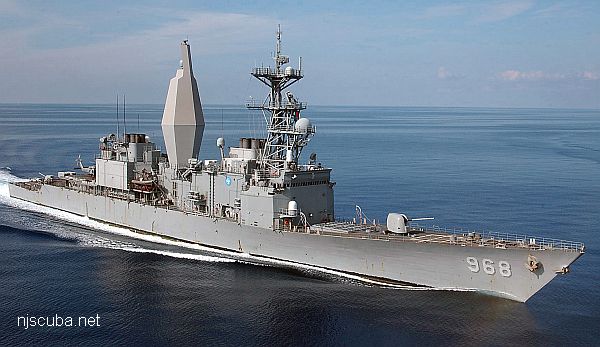
- Type:
- artificial reef, Spruance-class destroyer, US Navy
- Built:
- 1975, Ingalls Shipbuilding, Pascagoula MS USA
- Specs:
- ( 563 x 55 ft ) 8,040 tons
- Sunk:
- Wednesday, Aug 10, 2011 - DelJerseyLand Artificial Reef
- GPS:
- 38°30.850' -74°30.656' originally, now ???
- Depth:
- 130 ft

The USS Radford was a Spruance-class destroyer of the US Navy. The "Spru-cans" were a controversial design - huge, as big as World War II light cruisers, with very little armament showing, although they were in fact very well-armed. The Spruances' mission was primarily anti-submarine fleet escort. The same basic hull was used on the Ticonderoga-class cruiser, whose mission is primarily anti-air escort. ( The difference between destroyer and cruiser in the modern navy is mission, not size. )
Radford had a long and checkered 26-year career. Talk of preserving a Spruance as a museum ship came to nothing, as these ships are too big to make a practical museum, and don't have the history and public interest of a World War Two vessel. Instead, most were used as targets in live-fire training exercises. By the late 2000s, Radford was the last Spruance left afloat and was donated to the Delaware artificial reef program. Delaware, New Jersey, and Maryland collaborated on the project.
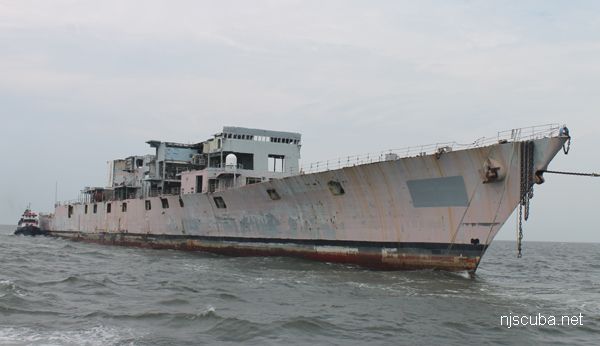
The vessel was cleaned and 'prepared' in the Philadelphia Navy Yard. The picture above gives an idea of just how 'prepared' the ship was at this point - it is completely gutted. At the time of its sinking, it was the longest artificial reef in the North Atlantic Ocean, a record previously held by the Algol, but that soon changed.
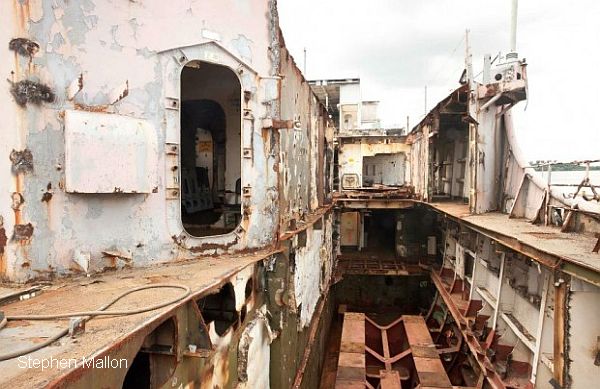
There is a reason destroyers are called "tin-cans" - they are built light, for speed. On the Spruances, the superstructure is aluminum, held to the steel hull with clamps. The joint is sealed with the biggest O-ring I've ever seen, which also helps control the inevitable dissimilar-metals reaction that would otherwise eat up the ship. This all worked fine as long as it was maintained by a Navy crew, but how long will it last after it is left to corrode in the sea?
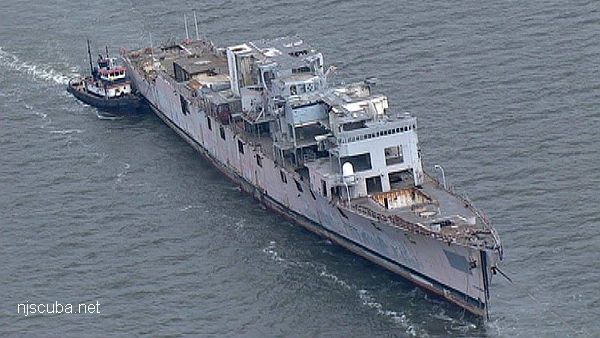
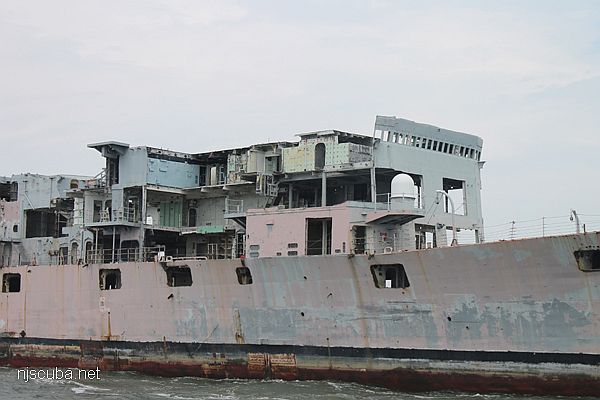
In the name of 'diver safety,' more than half the superstructure was hacked away, including most of the exterior walls and roof, leaving the much thinner interior decks and partitions to stand on their own. The valuable aluminum was sold for scrap, I'm surprised they left any of it at all. What is left is so structurally compromised that it will fall apart in a few years, if it doesn't just fall off entirely when the clamps holding it to the hull fail. The Radford is built like a giant subway car, and I would expect it to last about as long. It was a very poor choice for a reef, and a very expensive one.
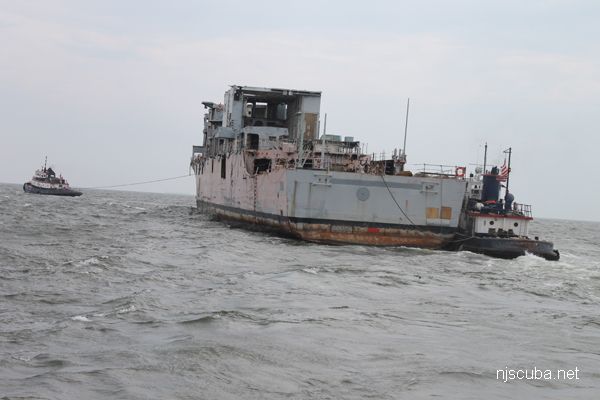

The sinking went off without a hitch, the vessel landing upright on the bottom as intended. But it was then subjected to two of the worst hurricanes of the last 50 years - Irene and then Sandy, which broke the hull into two, and then three pieces, scattered and separated by several hundred feet. The lightly-constructed hull is going to pieces at an alarming rate.
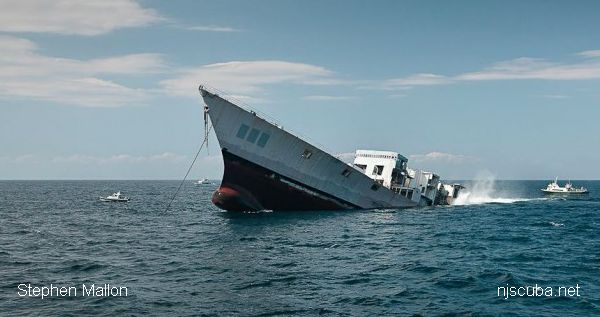
Radford sank stern-first. The broad flat stern resting on the bottom, together with most of the top-weight having been removed during 'preparation', caused her to remain upright initially. The stress of hitting the bottom probably started the stern breaking off the day she was sunk. You can also see the bulbous bow, which raised the vessel off the bottom and eventually caused the front third to break off.
On the chart above, the bow is fallen over in the original location, while the main body of the wreck is reported to have moved approximately 200 feet southeast, and remains upright. The fantail has broken off before the aft turret. It was probably wrenched off by the rudders stuck in the sand when the main hull went for a walk. I have seen no report of where the stern is, except that it is apparently not to the northwest.
Part of the problem was that the ship had not been down long enough to 'bed-down' in the bottom, which would have secured it against the storm surge. That was just bad luck. But a larger part of the problem is that it really is a "tin-can" - compare to the Algol, which is 50 feet shorter, and, at 13,000 tons, 5,000 tons of steel heavier. Algol suffered no damage from the same storms, although it also had the advantage of having set into in the bottom for over 20 years.
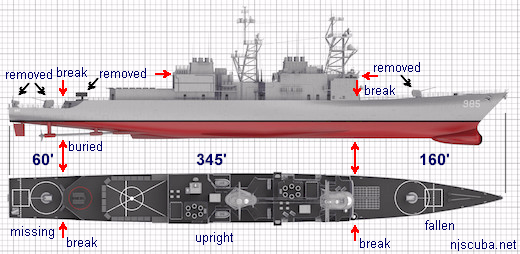
Above is a drawing of an intact Spruance-class destroyer. The red arrows mark the locations of the breaks in the Radford, along with the resulting lengths of the pieces. Also noted is the removal of points of interest by the Navy, like the obsolete gun turrets and missile launchers. Of course, the Radford was never intact, to begin with - the masts would be much too tall for reefing and had to be removed, and then most of the superstructure was hacked away as well. The next stage in the all-too-fast deterioration of the wreck will be for the superstructure to come off entirely, leaving basically just a blunt-ended tub. In a few years, Radford will have broken down to the point that it is indistinguishable from a big barge, and a few years after that, it will be a pile of rubble. Once again, the reason for sinking this thing was ... ?
( Actually, the Navy had to remove all that stuff. Otherwise, this being the Northeast, not the Caribbean, some jackass would have wanted a gun turret for his front lawn. )
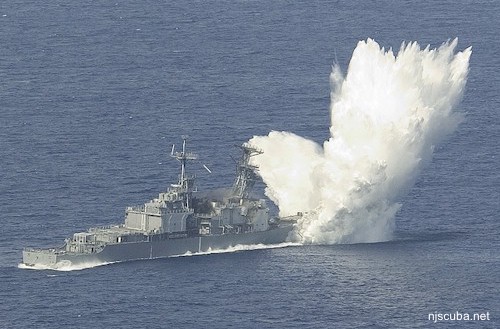
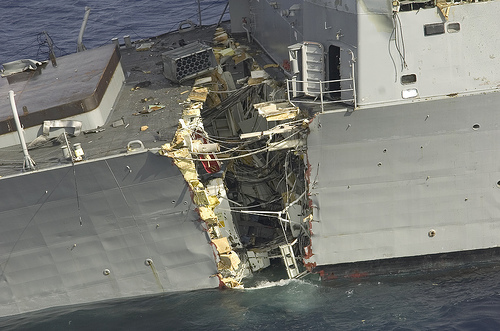
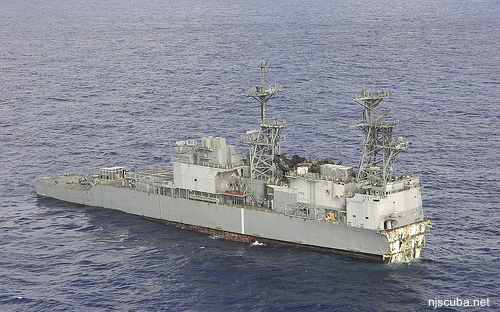
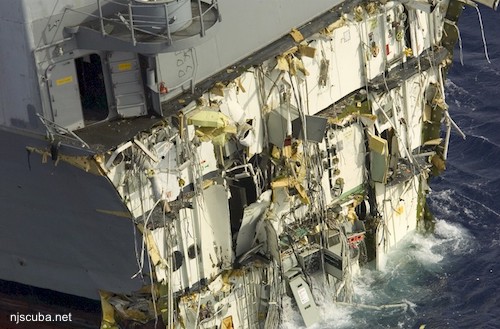
video courtesy of Dan Crowell
video courtesy of Dan Crowell
So, was the reefing of the Radford a success? The project cost $945,000 and sucked the life out of three reef programs for over a year. The Radford was only briefly the biggest reef on the East Coast before it broke apart. However, it was the most expensive by far - a record that is unlikely to ever be broken. A 100-foot barge or tugboat costs $9000-$10,000 to prepare and sink. So six of them end-to-end, equivalent to one mutilated Spruance, would cost $60,000. The reef programs claim that the Radford cost them nothing. That million dollars came from somewhere, and could have been put to much better use.
One of the goals was to create the biggest, most awesome dive site on the East Coast. But as you can see, by the time she was sunk, all that remained of the Radford was a sad mutilated hulk, the Navy and the salvagers removed everything they possibly could. No other steel ship reefed in the Mid-Atlantic region has broken apart so fast. The Radford is not a picturesque dive with real points of interest like the Keith Tibbetts or the Oriskany, it is just a stripped, broken ruin, that cost a million dollars.
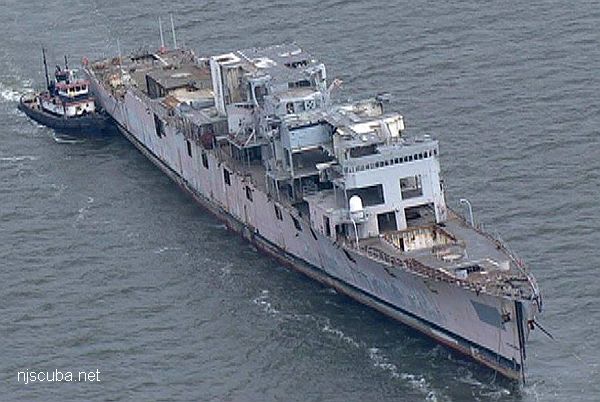
This overhead shot really shows how carved-up the ship is. After a few years of corrosion and winter storms, what's left of the superstructure will collapse like a house of cards.
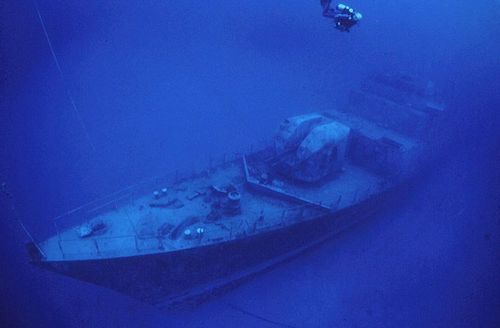
Another issue with the Radford is the location. The DelJerseyLand reef is roughly 28 miles offshore, and more than 30 miles from most departure points. For a light speedy fishing boat, that's not so much, but for a heavily loaded, slow dive boat, that is a long run, especially given today's fuel prices. Even the Oriskany was sunk closer than that - 22 miles out in the Gulf of Mexico, not the stormy North Atlantic. It will take an exceedingly fine day for anyone to attempt a trip to the Radford, and we all know how many of those we get every year. Then there's the depth - 140 feet to the bottom, with the wreck collapsing fast. This million-dollar baby is not going to get many visitors, at least not divers. And fishermen don't really care what they are fishing on, as long as they catch fish. Those six barges would be all the same to them, for a fraction of the cost.
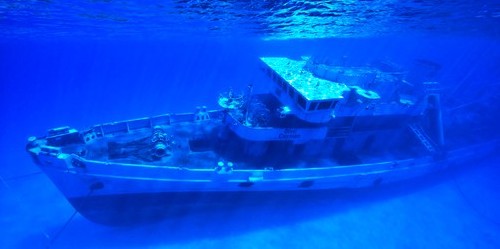
While three states' reef programs were occupied with the Radford, much more suitable vessels were lost, like the USS Kittiwake, which went to the Cayman Islands
I don't think any of this constitutes success - a million dollars for a gutted hulk sunk in the middle of nowhere that fell apart in two years. The Radford project is a failure in every way, and it was destined to be before it was even begun. It cost way too much for way too little benefit to anyone. Of course, the fish benefit from any reef, but I can't help thinking that 100 tugboats and barges would have been better than one rapidly-decaying tin-can, for the same price. And those tugboats and barges could be sunk in much more accessible locations for people. To add to the injury - while the reef programs were mired in the Radford, much more suitable vessels got away, like the Kittiwake above. In fact, looking at the bigger picture over the last decade, I would call the Radford a disaster for the New Jersey reef program. It hijacked what little money was available in a period of tight funding and ugly politics. I won't speak for Delaware and Maryland, but New Jersey should never have gotten involved.
I can understand how everyone got swept up in this boondoggle - "Sink a destroyer! Wow, what a great idea!" Not so much, as it turns out. But once you get past the "it's huge" factor, reefing the Radford was downright stupid, the Navy should have used it for a target like all the rest of the Spru-cans. Am I against sinking big ships as reefs? Certainly not - the Algol is a huge and ongoing success. The Navy still has a number of similar vessels that could be donated as reefs. But you need the right place to do it, and the right vessel. DelJerseyLand isn't the right place for anything, and the Radford was not the right subject.
Don't get me wrong - New Jersey's artificial reef program is the best in the world, and Delaware's is nothing short of amazing - what they have done in just a few short years. But the Radford has no place in that, it was pure folly, and a mistake that should never be repeated.
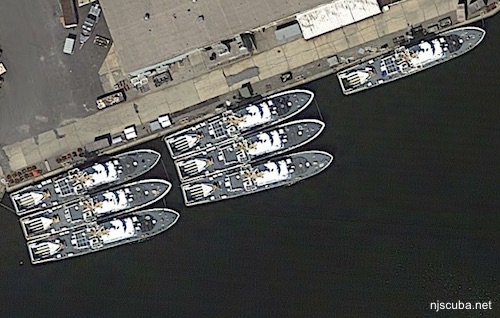
Seven Coast Guard cutters await scrapping in 2010 - they would have made perfect reefs. Instead, all efforts were concentrated on the Radford. When you figure in all the foregone opportunities, the Radford project was a complete disaster. Fortunately, things have since gotten back on track.
By 2016, it seems the Radford is completely forgotten - no dive or fishing reports in years.

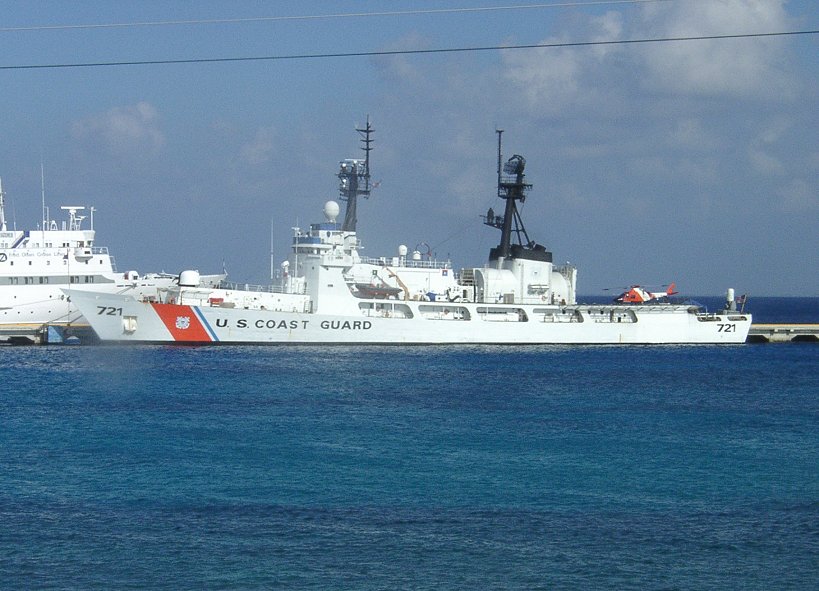
Questions or Inquiries?
Just want to say Hello? Sign the .